Bill Heard, Special to the U-T, October 2012
San Diego has many memorials honoring the men, women, ships, and aircraft that have served our nation. One of the most inspiring, but least known, is a memorial to the 2,564 members of the Navy and Coast Guard who lost their lives while serving in Vietnam from 1960 to 1975.
The Vietnam Unit Memorial Monument stands in a peaceful, grassy area of the Naval Amphibious Base on Coronado’s Silver Strand, less than a mile south of the Hotel del Coronado. Because it is located on a secure military base, members of the public seldom visit. Even many veterans and active-duty service members who would have access to the base aren’t aware of it.
And that’s a shame, because the monument is impressive and well-maintained by the VUMM Foundation and its member organizations, the Swift Boat Sailors Association, the Gamewardens of Vietnam, and the Mobile Riverine Force Association.
Approaching the memorial, situated at Rendova and Tulagi roads on the south side of the amphibious base, the visitor sees a curved, 10-foot-high, 66-foot-long wall inscribed with the name of the memorial and topped by an American flag and the flags of the 50 states.
Affixed to the memorial’s interior wall are 26 stainless steel plaques listing in alphabetical order the names and ranks, commands, hometowns, and dates of death of each of the 2,564 deceased. Among the names are those of shipboard sailors and officers, Coast Guardsmen, air crewmen and pilots, and Nacy personnel who served with Air Force and Army units. About a third of those listed were Navy hospital corpsmen who served with the Marines.
Four other plaques list the names of those posthumously awarded the Medal of Honor and the Navy Cross.
The information was compiled during an exhaustive two-year study by retired Navy Captain Ken McGhee of San Diego, a former swift boat division commander and the foundation’s first president.
The names have an impact on visitors. Recently a four-member team of SeaBees was helping erect a shelter on the memorial grounds. One of the young men of told foundation president and retired Navy Captain Paul Murphy that his grandfather had been one of 134 crewmen killed in 1967 when fire broke out aboard the aircraft carrier Forrestal in the Gulf of Tonkin.
Murphy walked the young man over to the wall and showed him his grandfather’s name. “He was very moved to see it. All four of the SeaBees were moved to be doing a building project at the memorial.”
Arrayed across from the memorial wall are three examples of river craft used in Vietnam: A 31-foot river patrol boat (PBR), a 50-foot swift boat (PCF) and a 61-foot command communications boat (CCB). Although none of the vessels on display saw service in Vietnam, similar boats served in the “Brown Water Navy,” operating in the treacherous inland waterways of Vietnam.
PBR crews often searched local craft suspected of smuggling arms to the Viet Cong. They frequently engaged in firefights and transported SEALs and small Army units. The swift boats of Operation Market Time patrolled the Vietnam coast and often operated in the rivers, interdicting weapons shipments and supporting SEALs.
The heavily armed CCBs—sometimes called “Monitors” because of their resemblance to Civil War ships—were the command ships of the Mobile Riverine Force and were equipped with communications gear that allowed mission commanders to direct combat operations.
BEtween the boats and the wall stands a 12-foot obelisk erected by the Gamewardens of Vietnam. Among other information, it lists the members of Task Force 116 who were killed during Operation Gamewarden in the Mekong Delta, 1966 to 1968.
The Vietnam Unit Memorial Monument—dedicated on Armed Forces Day in May 2005—was constructed entirely with private funds and with contributions from member organizations. Foundation members and a working party of veterans contributed their labor during the five-year construction period. The foundation signed a long-term agreement with the Navy in 1999 to manage the memorial site.
The three Brown Water veterans groups are responsible for the maintenance of the boats they provided for the memorial. And foundation members, including Murphy and other veterans, come out every week to cut the grass, fertilize and trim the bushes, and wash down the wall.
Information about the foundation, a 501(c)(3) nonprofit corporation, can be found at www.vummf.org. The website includes a brief history of the memorial, photos, and videos of memorial events, a description of the boats on display, a calendar of events, and links to veterans’ organizations.
To visit the Vietnam Unit Memorial Monument, veterans, active-duty personnel, and others with access to military bases can ask for directions at the main gate on the bay side of Silver Strand Boulevard. Civilians who wish to arrange an individual or group tour of the memorial may click on the “Visiting the Memorial” link on the foundation website homepage for a map and a list of contacts and phone numbers.
Last month, as he contemplated the memorial and recalled the years of effort by the many organizations and veterans involved, Murphy said, “It’s become something we never conceived it would. Every single week, we have ceremonies—retirements, graduations, changes of commands. It’s become a real focal point here at the amphibious base.”
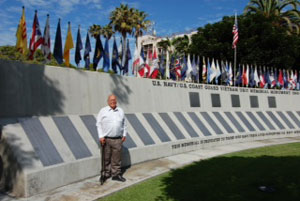
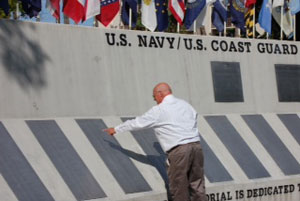
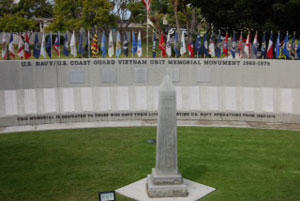
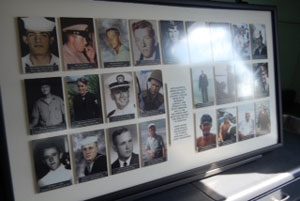
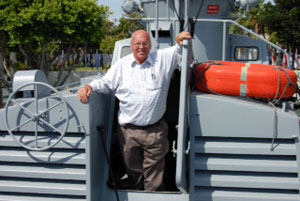
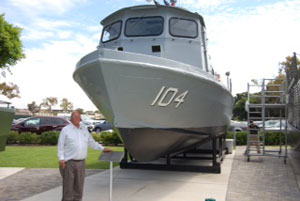
1943–1969
LTJG Crosby was the commander of PCF (Patrol Craft Fast) 21 in Vietnam. These Swift boats (as they were called) conducted coastal patrols and provided transport and escorts deep into rivers. Fifty feet long, aluminum hulled, with crews of six sailors and one officer, they carried three .50 caliber Browning machine guns, a mortar, grenades and small arms. The PCFs had little armor, relying on speed (25 knots) and firepower.
Crosby had Swift boat training at the U.S. Navy Amphibious Base in Coronado, CA. In October 1968, he went to Vietnam for a one–year tour in a combat zone, initially aboard PCF 21. On April 12, 1969, this was one of thirteen Swifts transporting South Vietnamese marines and their equipment and supplies up the Rach Duong Keo River. After five of the Swifts unloaded their troops, the remaining eight continued upriver. The Vietcong ambushed the convoy, and Crosby’s PCF 21 and another Swift were hit with rockets, mines and other weapons, and engulfed in flames. Nonetheless, Crosby was able to withdraw and return to base, saving his crew.
On September 25, 1969, near the end of his twelve–month tour, he was assigned as an instructor for a new crew from Coronado as they prepared for their first Swift mission on PCF 13. Crosby and the new commander were standing in the stern of PCF 13 when Crosby was shot in the stomach by a round accidentally fired from the aft Browning machine gun four feet away. He died the next day at an Army hospital.
Crosby came from South Hamilton on Boston’s North Shore, and attended the Lenox School in western Massachusetts. He then went to Cornell University, where he joined the Sigma Alpha Epsilon fraternity. He graduated in 1966 with a bachelor’s degree in Civil Engineering. In the U.S. Navy, Crosby served on the USS Harwood DD 861, before his Coronado Swift boat training. While in Vietnam, he had been accepted in the Cornell Masters in Engineering program, and he had planned to return to his alma mater after his discharge from the Navy.
Crosby was loved and respected by all who knew him: his teachers and fellow students at Lenox, his SAE fraternity brothers at Cornell, and the Swift boat community in Vietnam. He is acknowledged and praised in several books: Tour of Duty, by historian David Brinkley; My Father, My Son, by Admiral Elmo Zumwalt; and Every Day Is Extra, by Senator and Secretary of State John Kerry. The PCF 21 flag was given to his parents, who in turn gave it to Sigma Alpha Epsilon. He was an only child. The above rubbing shows Crosby’s name as it appears on the Vietnam Memorial Wall in Washington.

